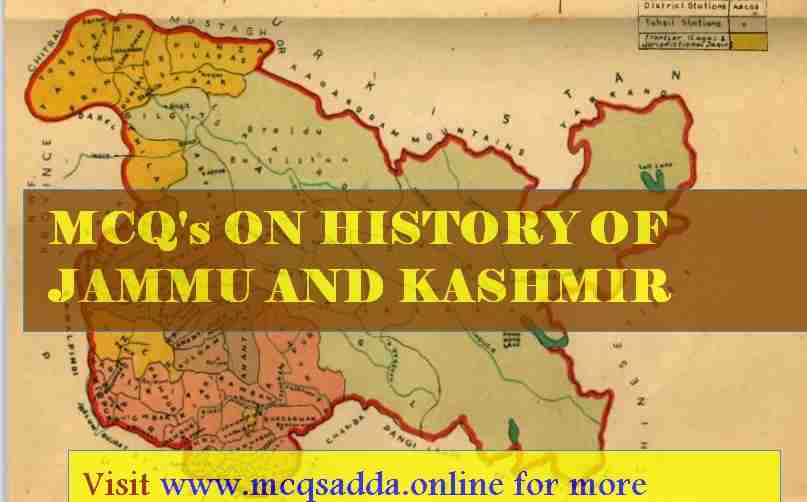Ancient History of Jammu and Kashmir is very important for all competitive exams . The Mcqs on Ancient History of Jammu and Kashmir are asked in JKSSB and JKPSC exams. Practice MCQs on Ancient History of Jammu and Kashmir with answers.
MCQs on Ancient History of Jammu and Kashmir Practice Now
The ancient history of Jammu and Kashmir, located in the northernmost part of India, is rich and diverse, with a heritage that spans several millennia. The region has witnessed the rise and fall of numerous empires and dynasties, each leaving its mark on the cultural, social, and political landscape of the area.
The earliest known settlements in the region date back to the Neolithic period, around 3000 BCE, with evidence of human habitation found in the form of tools and pottery. The area has been influenced by various civilizations, including the Indus Valley Civilization, which flourished around 2500 BCE.
In the 6th century BCE, the region came under the rule of the Achaemenid Empire, followed by the Mauryan Empire under Emperor Ashoka in the 3rd century BCE. During the reign of Ashoka, Buddhism was introduced to the region, and numerous Buddhist monasteries and stupas were built.
In the 6th century CE, the region witnessed the advent of the Gupta Empire, which brought about a period of prosperity and cultural development. However, the Gupta Empire eventually declined, and the region fell under the influence of various dynasties, including the Kushans, the Huns, and the Shahi’s.
Best book for Jammu and Kashmir History
MCQs on Ancient History of Jammu and Kashmir
1.According to Nilmat Purana who were the original inhabitants of Kashmir valley?
A) shivas
B) Nagas
C) Brahmins
D None of above
2. The people named Kashmir as
A) Kashyap -Mar
B) Kashi-Mi-Lo
C) Kashmir -o
D) kashwari
3. Who is regarded the Kashmir’s first historian ?
A) Hiuen Tsang
B) Lalitaditya
C) Pandit kulhana
D) Ashoka
4. Rajatarangini means?
A) River of Queen’s
B) River of Pandits
C) River of Soldier’s
D) River of Kings
5.Who translated Rajatarangini into Persian ?
A) Zain-ul-Aabideen
B) Shivara
C) Mulla Ahmad
D) Syed khaleel
6.The first Neolithic site discovered in Kashmir is ?
A) Gufkral
B) Burzahom
C) kralkhud
D) shivpora
7. Who translated Rajatarangini into English?
A) Aurel stein
B) Fa-Hien
C) Alexander Cunningham
D Jonaraja
8. Who translated Rajatarangini into Kashmiri ?
A) Mir Rehmat -ul -khan
B) Nazir Farooqi
C) Dr. Bashar Basheer
D) khan Qisar Majeed
9. The first king of Kashmir mentioned by Kalhan in Rajatarangini was ?
A) Jaluka
B) Ashoka
C) Gonanda 1
D) Kanshika
10. Who founded the old city of srinagar now called as Pandrethan
A) Bhimbisara
B) Hushka
C) Kanshika
D) Ashoka
11. The fourth Buddhist council held by Kanishka at
A) Pandrethan
B) Huskapura
C) kundalvan
D) kanishkpora
12. Karkota dynasty also known as
A) Sagas
B) Brahmins
C) Nagas
D) Shivas
13. karkota dynasty was founded by
A) Durlabhavardhana
B) Lalitaditya
C) Harsha
D) None of Above
14. During who’s reign, the Chinese Pilgrim Hiuen Tsang visited Kashmir ?
A) Lalitaditya
B) Jayapida
C) Durlabhavardhana
D) Avanitirarman
15.Who is known as Sumudra Gupta of Kashmir?
A) Lalitaditya
B) Avantivarman
C) Durlabhavardhana
D) Non of Above
16. Who is the author of Tawarikh-i-Kashmir ?
A) MirzaMirza Haider Duglat
B) Mailk Haider
C) Shairf – ud- din Yazdi
D) Hasan Shah
17. Who built. martand Temple in Mattan ?
A) Lalitaditya
B) Avantivarman
C) Durlabhavardhana
D) Jaluka
18. Who is the author of Zafar- Nama ?
A) Mailk Haider
B) Shairf – ud- din Yazdi
D) Hasan Shah
C) Pandith Birbal Kachru
19.Seeds of which crop has been found at Burzahom?
A) Lentils
B) Wheat
C) Barley
D) All of these.
20. Which of the following king founded the Pravarasenpura City of Srinagar?
A) Pravarasena I
B) Pravarasena II
C) Ashoka
D) None of these
21. Who started Kashmiri Shaivism?
A) Kshemraja
B) Kallata
C) Abhinavgupta
D) Vasugupta
22. To preach the faith of Buddha in the Kashmir valley, who appointed by Ashoka Buddhist missionary?
A. Abhinavgupta
B. Kanshika
C. Majjhantika
D. Jayapida
23. Which of the following is not a Neolithic site of Kashmir?
A) Gofkral
B) Hariparigom
C) Pampur
D) Wakura
24. The beginning of Kashmir Shaivism is marked by ?
A. Shivasutra
B. Paramartha
C. Sivadrishti
D. Sarvasya
25.Hephthalites Huns (Central Asian people) also known
A. Black Hunsf
B. Pink Huns
C. White Huns
D. Yellow Huns
What evidence exists of ancient civilizations in Jammu and Kashmir?
Archaeological findings, such as tools and pottery, dating back to the Neolithic period, provide evidence of ancient settlements in the region, while remnants of Buddhist monasteries and stupas highlight the influence of Buddhism during the reign of Ashoka.
Which empires ruled over Jammu and Kashmir in ancient times?
Jammu and Kashmir witnessed the rule of various empires, including the Achaemenid Empire, Mauryan Empire under Ashoka, Gupta Empire, and later the influence of dynasties like the Kushans, Huns, Shahis, and the Dogra dynasty.
What is the ancient name of Jammu and Kashmir?
The ancient name of Jammu and Kashmir was “Kashmir.” The region was commonly referred to as Kashmir in historical texts and accounts, highlighting its significance as a distinct geographical and cultural entity.
Who was the first king of ancient Kashmir?
The first king of ancient Kashmir was King Gonanda I. He belonged to the Gonanda dynasty and is believed to have ruled during the 6th century BCE. King Gonanda I is mentioned in ancient Sanskrit texts like the Rajatarangini, which chronicles the history of Kashmir.
Who is the first historian of Jammu and Kashmir?
The first historian of Jammu and Kashmir is Kalhana, who authored the Rajatarangini in the 12th century CE. The Rajatarangini is an important historical chronicle that provides valuable insights into the ancient history, culture, and rulers of Kashmir. Kalhana’s work is considered a significant contribution to the historiography of the region.
